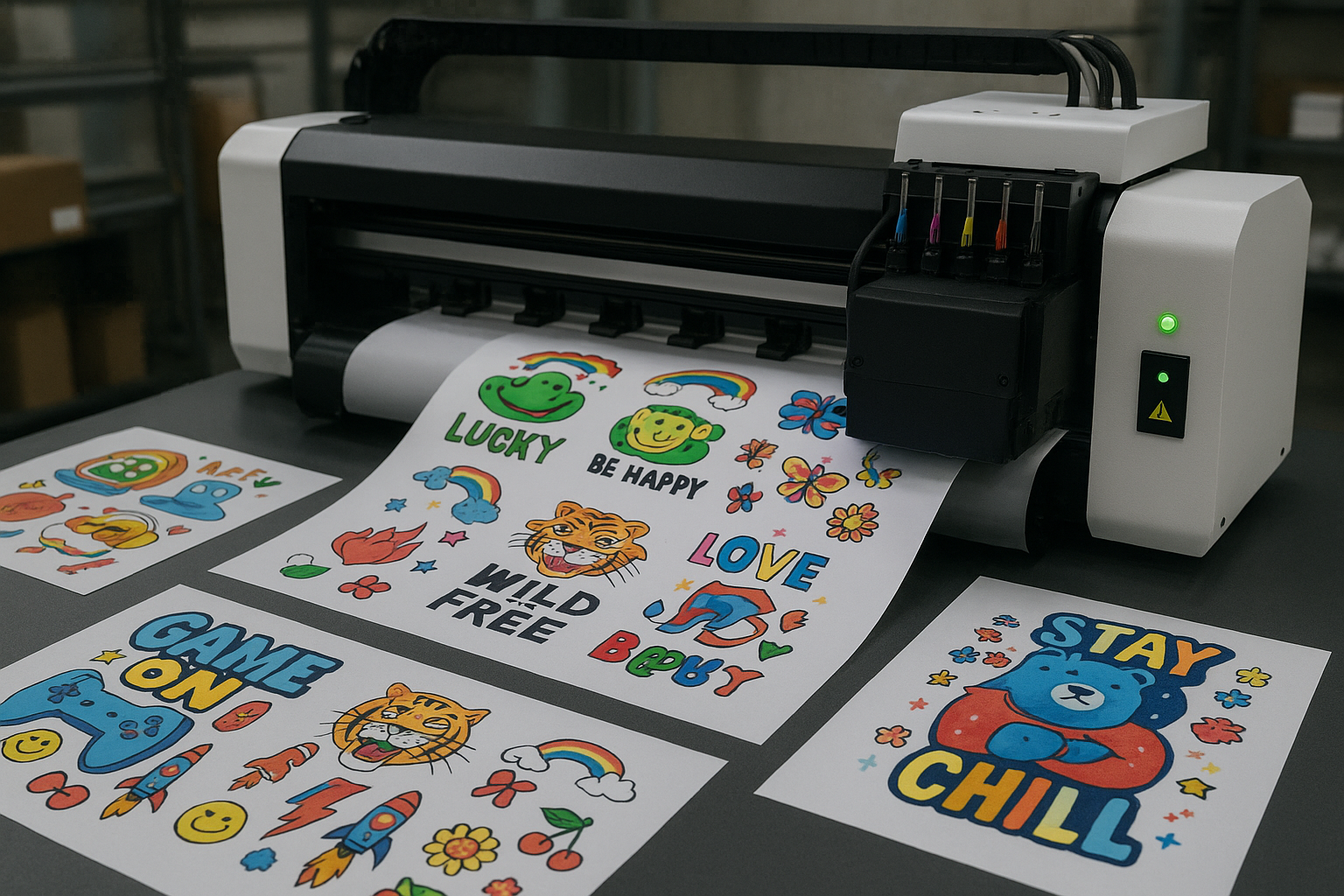
Step 1: Digital Processing
When you hit “print,” your computer doesn’t just send the image as-is to the printer. Instead, it converts your document into a language the printer can understand – typically PostScript or PCL (Printer Control Language). This process is called “rasterization,” and it’s where your smooth curves and gradients get converted into the dots that will eventually appear on paper. Think of it like translating a book into another language. The meaning stays the same, but the words change completely.Step 2: Data Transmission
The rasterized data travels to your printer via USB, Wi-Fi, or Ethernet. Modern printers have built-in computers (called print controllers) that receive this data and prepare it for the actual printing process.Step 3: Physical Printing
This is where the magic happens. The printer’s mechanical systems spring into action, precisely placing millions of tiny ink droplets to recreate your digital image on physical media. Now, let’s zoom in on that third step – because that’s where the real magic happens.The Heart of the Machine: Print Head Technology
The print head is the business end of any inkjet printer. It’s where digital data becomes physical reality, and understanding how it works is key to understanding the entire printing process.Anatomy of a Print Head
Imagine a print head as a miniature city of microscopic factories. Each “factory” (called a nozzle) is responsible for producing and delivering ink droplets to specific locations on your paper. A typical print head contains hundreds or even thousands of these nozzles, each smaller than a human hair. Here’s what you’ll find inside a modern print head: Ink Chambers: Tiny reservoirs that hold ink ready for firing Nozzles: The actual openings where ink droplets exit Actuators: The mechanisms that force ink out of the nozzles Filters: Screens that prevent debris from clogging the systemThe Two Main Print Head Technologies
Remember how I mentioned thermal and piezoelectric technologies in our previous discussion? This is where they really matter. Let me walk you through both: Thermal Inkjet Print Heads These use heat to create the pressure needed to eject ink droplets. Here’s the step-by-step process:- Heating Phase: A resistive heating element (called a thermal resistor) heats up to about 300°C in microseconds
- Bubble Formation: The intense heat vaporizes a tiny amount of ink, creating a rapidly expanding bubble
- Ejection: The bubble’s expansion forces an ink droplet through the nozzle
- Collapse: The bubble collapses, creating suction that refills the chamber with fresh ink
- Reset: The system is ready for the next firing cycle
- Electrical Pulse: A precise electrical signal is applied to a piezoelectric crystal
- Crystal Flexing: The crystal changes shape, creating pressure in the ink chamber
- Droplet Formation: This pressure forces a precisely controlled droplet through the nozzle
- Recovery: The crystal returns to its original shape, refilling the chamber
The Precision Dance: Paper Movement and Timing
Creating a perfect print requires more than just squirting ink in the right direction. The paper (or other printing material) must move with incredible precision while the print head fires millions of droplets with perfect timing.The Paper Path System
Most inkjet printers use one of two paper handling systems: Friction Feed System: Used in most desktop printers, this system grips the paper with rubber rollers and moves it past the print head. The paper typically moves in small, precise increments between each pass of the print head. Continuous Feed System: Found in large format and industrial printers, this system moves paper continuously while the print head fires droplets. The timing must be absolutely perfect – fire too early or too late, and your image will be distorted.The Stepper Motor Mystery
How does the printer know exactly where the paper is at any given moment? The answer lies in stepper motors – specialized motors that rotate in precise, measurable increments. Think of a stepper motor like a clock hand that can move in perfect one-second increments. Instead of seconds, stepper motors move in degrees or fractions of degrees. This precision allows the printer to position paper and print heads with incredible accuracy. I once worked with a large format printer that could position its print head to within 0.01 millimeters – that’s about one-tenth the width of a human hair!Color Creation: The CMYK Magic
Here’s where things get really interesting. Your printer doesn’t actually contain every color you see in your prints. Instead, it uses just four colors – Cyan, Magenta, Yellow, and Black (CMYK) – to create the illusion of millions of colors.How Four Colors Become Millions
This process, called “color mixing,” works through a combination of: Overlapping: Different colored inks placed on top of each other Dithering: Patterns of colored dots that create the illusion of new colors when viewed from a distance Halftoning: Varying the size and spacing of dots to create different shades Let me give you a real-world example. To print green, your printer might place yellow and cyan dots very close together. Your eye sees them as green, even though no green ink was used.Beyond Basic CMYK
Many modern printers go beyond the basic four colors. Photo printers often include:- Light Cyan and Light Magenta: For smoother skin tones and subtle gradations
- Gray: For better black and white printing
- Orange and Green: For more vibrant colors
- White: For printing on dark materials
Resolution: Understanding Dots Per Inch (DPI)
When printer manufacturers talk about “1200 DPI” or “2400 DPI,” what do they actually mean? And more importantly, why should you care?DPI Explained Simply
DPI stands for “Dots Per Inch.” It’s a measure of how many individual ink droplets your printer can place within a one-inch line. Higher DPI means more dots, which generally translates to finer detail and smoother gradations. But here’s something most people don’t realize: not all dots are created equal. A 1200 DPI printer that can vary droplet size might produce better results than a 2400 DPI printer with fixed droplet size.Variable Droplet Technology
Modern inkjet printers can create droplets of different sizes – sometimes as small as 1 picoliter (that’s one trillionth of a liter). This variable droplet technology allows for:- Fine details: Tiny droplets for sharp text and intricate graphics
- Smooth gradations: Medium droplets for natural-looking transitions
- Solid coverage: Large droplets for filling in large areas efficiently
The Ink Delivery System: From Cartridge to Paper
Getting ink from its storage location to the print head requires a sophisticated delivery system. Let’s trace this path:Ink Cartridge Design
Modern ink cartridges are marvels of engineering. They must:- Store ink without it drying out or settling
- Maintain consistent pressure as ink is consumed
- Prevent air bubbles from entering the system
- Filter out contaminants that could clog nozzles
The Ink Supply Chain
Cartridge-Based Systems: Ink flows from cartridges through tubes to the print head. As ink is consumed, air enters the cartridge to prevent vacuum formation. Continuous Ink Supply Systems (CISS): Used in high-volume applications, these systems feed ink from large external tanks. They’re more economical for heavy users but require more maintenance. Integrated Print Heads: Some printers combine the print head and ink supply in a single replaceable unit. This ensures optimal performance but increases operating costs.Quality Control: How Printers Maintain Consistency
Printing thousands of perfect pages requires constant quality monitoring and adjustment. Here’s how printers maintain consistency:Automatic Nozzle Checking
Most modern printers periodically print test patterns to check if all nozzles are firing correctly. If a nozzle is clogged or misfiring, the printer can compensate by using adjacent nozzles or trigger a cleaning cycle.Head Cleaning Cycles
When nozzles become clogged, printers use various cleaning methods:- Purging: Forcing ink through nozzles to clear blockages
- Wiping: Physical cleaning of nozzle surfaces
- Soaking: Allowing cleaning solution to dissolve dried ink
Calibration and Alignment
Print heads must be perfectly aligned to prevent color shifts and banding. Printers regularly perform automatic calibration routines, adjusting timing and positioning to maintain optimal results.Common Problems and What They Tell Us
Understanding how inkjet printers work helps explain why certain problems occur:Banding (Horizontal Lines)
Usually caused by:- Clogged nozzles
- Inconsistent paper movement
- Print head misalignment
Color Shifts
Often result from:- Empty or low ink levels
- Expired ink cartridges
- Incorrect color profiles
Blurry Prints
Typically caused by:- Wrong paper type settings
- Excessive ink saturation
- Print head height issues
The Software Side: RIP and Print Processing
While we’ve focused on hardware, software plays a crucial role in inkjet printing. The RIP (Raster Image Processor) is the brain that converts your digital files into the dot patterns that create your prints.What RIP Software Does
- File Interpretation: Converts various file formats into printable data
- Color Management: Ensures colors match your expectations
- Halftoning: Creates dot patterns for color mixing
- Print Optimization: Adjusts settings for different papers and inks
Advanced RIP Features
Modern RIP software includes:- Ink Limiting: Prevents paper from becoming oversaturated
- Linearization: Ensures consistent color density
- Sharpening: Enhances detail in fine lines and text
- Nozzle Compensation: Works around defective nozzles
Speed vs. Quality: The Eternal Trade-off
Every inkjet printer faces the fundamental trade-off between speed and quality. Understanding this relationship helps explain why printers have different speed settings:Draft Mode
- Fewer passes: Print head covers the paper in fewer passes
- Lower resolution: Uses fewer dots per inch
- Larger droplets: Faster ink delivery but less detail
- Result: Fast printing with acceptable quality for proofs
Normal Mode
- Balanced approach: Compromise between speed and quality
- Standard resolution: Typical DPI for general printing
- Mixed droplet sizes: Optimizes for various content types
- Result: Good quality for everyday printing
Photo/High Quality Mode
- Multiple passes: Print head covers the same area several times
- Maximum resolution: Uses the printer’s highest DPI setting
- Variable droplets: Optimizes droplet size for each area
- Result: Highest quality but slowest printing
Environmental Factors That Affect Performance
Inkjet printers are sensitive to their environment. Here’s what affects their performance:Temperature
- Too cold: Ink becomes thick and flows poorly
- Too hot: Ink becomes thin and may cause bleeding
- Optimal range: Usually 65-75°F (18-24°C)
Humidity
- Too dry: Static electricity can affect paper feeding
- Too humid: Paper may curl and ink may not dry properly
- Optimal range: 40-60% relative humidity
Air Quality
- Dust: Can clog nozzles and affect print quality
- Chemicals: May react with inks or damage components
- Solution: Clean, filtered air is ideal
The Future of Inkjet Printing Mechanisms
Where is inkjet technology heading? Based on current research and industry trends, here’s what’s coming:Faster Print Heads
New materials and designs are enabling print heads with thousands of nozzles firing simultaneously, dramatically increasing print speeds.Smart Nozzles
Imagine nozzles that can adjust their own size and firing pattern based on the content being printed. This technology is already in development.3D Capabilities
Some manufacturers are exploring inkjet systems that can build up layers of material, effectively 3D printing with liquid materials.Sustainable Innovations
Water-based inks, biodegradable components, and energy-efficient designs are becoming priorities for manufacturers.Practical Tips for Better Understanding
Want to see inkjet printing in action? Here are some experiments you can try:The Magnifying Glass Test
Use a magnifying glass to examine your prints. You’ll see the individual dots that create the image – it’s amazing how your eye blends them into smooth colors and gradations.The Draft Mode Experiment
Print the same image in draft and photo modes. Compare the differences – you’ll understand the speed vs. quality trade-off viscerally.The Nozzle Check
Most printers have a built-in nozzle check function. Run it and examine the results. You’ll see exactly which nozzles are working and which might need cleaning.Conclusion: The Beautiful Complexity of Simplicity
When you understand how inkjet printers work, you realize that what seems like a simple process is actually an incredibly complex dance of precision engineering, advanced materials, and sophisticated software. Every time you print a document, thousands of components work together with microscopic precision to transform your digital vision into physical reality. The next time you watch an inkjet printer in action, remember what’s happening inside: stepper motors positioning paper with mechanical precision, print heads firing millions of droplets with perfect timing, and software orchestrating it all to create the colors and details you see. Understanding these mechanisms doesn’t just satisfy curiosity – it helps you make better printing decisions, troubleshoot problems more effectively, and appreciate the remarkable technology that we often take for granted. Whether you’re choosing your first printer or your fiftieth, remembering these fundamental principles will serve you well. After all, the best way to use any technology is to understand how it works. Want to dive deeper into printing technology? Check out our other articles on specific printer types, maintenance tips, and troubleshooting guides. And if you have questions about how inkjet printers work, feel free to reach out – I love discussing the fascinating world of printing technology.Technical Specifications Reference:
- Print head nozzle diameter: 10-50 micrometers
- Droplet volume: 1-50 picoliters
- Firing frequency: Up to 50,000 Hz
- Typical resolution: 300-2400 DPI
- Color gamut: sRGB to Adobe RGB depending on ink set

